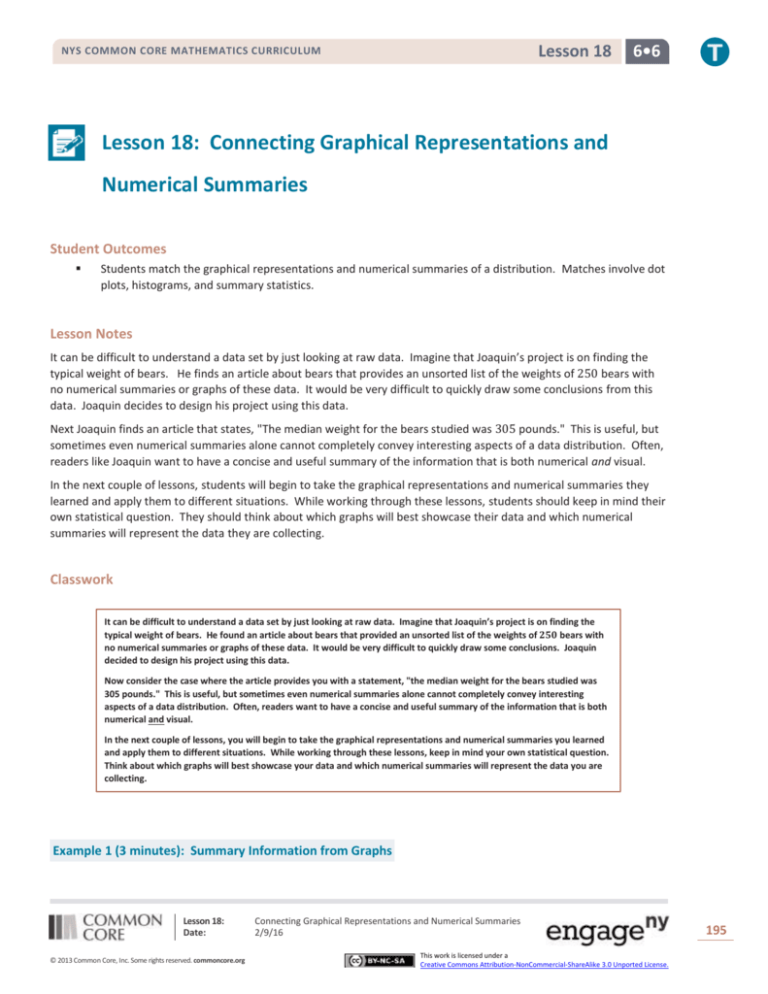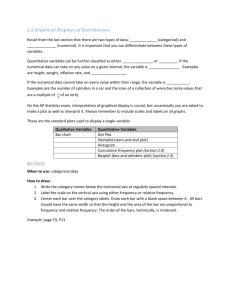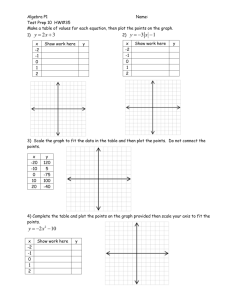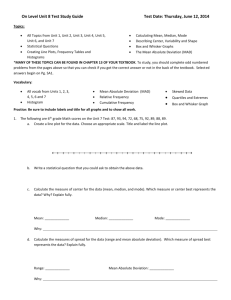
Lesson 18
NYS COMMON CORE MATHEMATICS CURRICULUM
6•6
Lesson 18: Connecting Graphical Representations and
Numerical Summaries
Student Outcomes
Students match the graphical representations and numerical summaries of a distribution. Matches involve dot
plots, histograms, and summary statistics.
Lesson Notes
It can be difficult to understand a data set by just looking at raw data. Imagine that Joaquin’s project is on finding the
typical weight of bears. He finds an article about bears that provides an unsorted list of the weights of 250 bears with
no numerical summaries or graphs of these data. It would be very difficult to quickly draw some conclusions from this
data. Joaquin decides to design his project using this data.
Next Joaquin finds an article that states, "The median weight for the bears studied was 305 pounds." This is useful, but
sometimes even numerical summaries alone cannot completely convey interesting aspects of a data distribution. Often,
readers like Joaquin want to have a concise and useful summary of the information that is both numerical and visual.
In the next couple of lessons, students will begin to take the graphical representations and numerical summaries they
learned and apply them to different situations. While working through these lessons, students should keep in mind their
own statistical question. They should think about which graphs will best showcase their data and which numerical
summaries will represent the data they are collecting.
Classwork
It can be difficult to understand a data set by just looking at raw data. Imagine that Joaquin’s project is on finding the
typical weight of bears. He found an article about bears that provided an unsorted list of the weights of 𝟐𝟓𝟎 bears with
no numerical summaries or graphs of these data. It would be very difficult to quickly draw some conclusions. Joaquin
decided to design his project using this data.
Now consider the case where the article provides you with a statement, "the median weight for the bears studied was
305 pounds." This is useful, but sometimes even numerical summaries alone cannot completely convey interesting
aspects of a data distribution. Often, readers want to have a concise and useful summary of the information that is both
numerical and visual.
In the next couple of lessons, you will begin to take the graphical representations and numerical summaries you learned
and apply them to different situations. While working through these lessons, keep in mind your own statistical question.
Think about which graphs will best showcase your data and which numerical summaries will represent the data you are
collecting.
Example 1 (3 minutes): Summary Information from Graphs
Lesson 18:
Date:
© 2013 Common Core, Inc. Some rights reserved. commoncore.org
Connecting Graphical Representations and Numerical Summaries
2/9/16
This work is licensed under a
Creative Commons Attribution-NonCommercial-ShareAlike 3.0 Unported License.
195
Lesson 18
NYS COMMON CORE MATHEMATICS CURRICULUM
6•6
Review dot plots and histograms. Important points are as follows:
MP.4
Each picture reveals a great deal about what is occurring.
Some pictures may look different from one another and highlight different aspects of the same data set, but
graphs of the same data set can still have several similarities and impart similar information.
Summary measures can be obtained or estimated from dot plots and histograms, and these measures
complement the graphical information.
Example 1: Summary Information from Graphs
Recall that a dot plot includes a dot on a scale or number line for each observation in a data set. Dots are stacked on top
of one another when there are multiple occurrences of a data value. Recall also that a histogram similarly uses a scale or
number line to present the frequency or relative frequency of groups of data based on intervals of equal width. For each
interval, the height of the bar is proportional to the number of observations in the interval; the taller the bar, the greater
the number of observations in that interval. This means that when both graphs are generated for a given data set, the
two graphs will display some similarities.
Here is a data set of the ages (in years) of 𝟒𝟑 participants in a recent local 𝟓-kilometer race.
20
45
32
51
57
38
30
18
32
61
26
30
30
43
31
50
29
30
35
23
32
34
49
36
47
36
34
41
34
27
74
34
36
38
21
41
35
37
46
30
41
28
41
Here are some summary statistics, a histogram, and a dot plot for the data:
Minimum = 𝟏𝟖, Q1 = 𝟑𝟎, Median = 𝟑𝟓, Q3 = 𝟒𝟏, Maximum = 𝟕𝟒; Mean = 𝟑𝟔. 𝟖𝟏, MAD = 𝟖. 𝟏
Lesson 18:
Date:
© 2013 Common Core, Inc. Some rights reserved. commoncore.org
Connecting Graphical Representations and Numerical Summaries
2/9/16
This work is licensed under a
Creative Commons Attribution-NonCommercial-ShareAlike 3.0 Unported License.
196
Lesson 18
NYS COMMON CORE MATHEMATICS CURRICULUM
6•6
Exercises 1–7 (7–10 minutes)
Pose these questions to students one at a time.
Exercises 1–7
1.
Based on the histogram, would you describe the shape of the data distribution as approximately symmetric or as
skewed? Would you have reached this same conclusion looking at the dot plot?
Both graphs show a slightly skewed right data distribution.
2.
Is it easier to see the shape of the data distribution from the histogram or the dot plot?
Generally, it is easier to see the shape of the data distribution from a histogram. In this case, the clustering and high
frequency of ages in the 𝟑𝟎s is more evident in the histogram.
3.
What is something you can see in the dot plot that is not as easy to see in the histogram?
When using the histogram, we cannot determine the exact minimum or maximum age—for example, we only know
that the minimum age is between 𝟏𝟓 and 𝟏𝟗 years of age. Also, we can only approximate the median (we generally
cannot figure out the exact median value from a histogram).
Since the dot plot provides us with a dot for each observation, we can obtain specific (or sometimes rounded) values
for a 𝟓-number summary—and the entire data set—from the dot plot. With the dot plot, we see that the minimum
is specifically 𝟏𝟖. The median is the 𝟐𝟐𝒏𝒅 observation (since there are 𝟒𝟑 observations) and the 𝟐𝟐𝒏𝒅 dot counting
from left to right is 𝟑𝟓 (we cannot be that precise with the histogram). The oldest runner (𝟕𝟒) also appears to be a
more extreme departure from the rest of the data in the dot plot as compared to the histogram.
4.
Do the dot plot and the histogram seem to be centered in about the same place?
Yes, as both graphs are based on the same data, they should generally communicate the same information
regarding center.
5.
Do both the dot plot and the histogram convey information about the variability in the age distribution?
Yes, as both graphs are based on the same data, they should generally communicate the same information
regarding variability. However, as mentioned earlier, the oldest runner (𝟕𝟒) appears to be a more extreme
departure from the rest of the data in the dot plot as compared to the histogram.
6.
If you did not have the original data set and only had the dot plot and the histogram, would you be able to find the
value of the median age from the dot plot?
Yes, see response to Exercise 3.
7.
MP.6
Explain why you would only be able to estimate the value of the median if you only had a histogram of the data.
The median is the 𝟐𝟐𝒏𝒅 ordered observation in this data set since there are 𝟒𝟑 observations. Counting from left to
right, we know that the first 𝟐𝟏 observations are in the first 𝟒 classes: 𝟏𝟓–𝟏𝟗 (𝟏 value), 𝟐𝟎–𝟐𝟒 (𝟑 more values),
𝟐𝟓–𝟐𝟗 (𝟒 more values), and 𝟑𝟎–𝟑𝟒 (𝟏𝟑 more values). Cumulatively, we have encountered the lowest 𝟐𝟏
observations by the time we are finished with the 𝟑𝟎–𝟑𝟒 class. So, the 𝟐𝟐𝒏𝒅 value must be in the next class, which is
𝟑𝟓–𝟑𝟗 years of age. We just cannot determine the exact value from the histogram.
Lesson 18:
Date:
© 2013 Common Core, Inc. Some rights reserved. commoncore.org
Connecting Graphical Representations and Numerical Summaries
2/9/16
This work is licensed under a
Creative Commons Attribution-NonCommercial-ShareAlike 3.0 Unported License.
197
Lesson 18
NYS COMMON CORE MATHEMATICS CURRICULUM
6•6
Exercises 8–13 (25 minutes): Graphs and Numerical Summaries
Pose the questions to students one at a time. Allow for more than one student to offer an answer for each question
encouraging a brief (2 minute) discussion.
Note: In some cases, the questions have multiple and/or inexact answers.
Exercises 8–13: Graphs and Numerical Summaries
8.
Suppose that a newspaper article was written about the race and the histogram of the ages from Example 1 was
shown in the article. The writer stated, “The race attracted many older runners this year; the median age was 𝟒𝟓.”
Explain how we would know that this is an incorrect statement based on just the histogram.
Several answers are possible, but students should concentrate on the shaded area (distribution) shown and the
definition of a median. Specifically, at 𝟒𝟓, it appears that less than half of the data are (or area is) at or above that
value (or alternatively, more than half of the data are at or below that value). Another approach would be to state
that the value at which the data (area) might be split, 𝟓𝟎% below/𝟓𝟎% above appears to be at a lower value than
𝟒𝟓 (or in the interval 𝟑𝟓–𝟑𝟗).
9.
One of the histograms below is another valid histogram for the runners’ ages. Select the correct histogram, and
explain how you determined which graph is valid (and which one is incorrect) based on the summary measures and
dot plot.
One of the objectives is to reinforce that there is more than one way to draw a proper histogram for a distribution.
This question is especially detail-oriented because students need to carefully reconcile components of the histogram
with the data set (either as shown in raw form or in the dot plot). The histogram on the right is the correct graph
because it is consistent with the dot pot/data. Most notably, the histogram on the right correctly shows there are 𝟑
runners in the 𝟏𝟎–𝟐𝟏 age group, while the left histogram shows only 𝟏 runner in the 𝟏𝟐–𝟐𝟑 age group (and there
are actually 𝟒 runners in that class). Other classes in the left histogram do not match the dot plot/data (e.g., the 𝟒𝟖–
𝟓𝟗 group), so several answers are possible.
Lesson 18:
Date:
© 2013 Common Core, Inc. Some rights reserved. commoncore.org
Connecting Graphical Representations and Numerical Summaries
2/9/16
This work is licensed under a
Creative Commons Attribution-NonCommercial-ShareAlike 3.0 Unported License.
198
Lesson 18
NYS COMMON CORE MATHEMATICS CURRICULUM
6•6
10. The histogram below represents the age distribution of the population of Kenya in 2010.
a.
How do we know from the graph above that the first quartile (Q1) of this age distribution is between 𝟓 and 𝟗
years of age?
Since a histogram should display information that is consistent with summary measures, we are seeking a
data value such that 𝟐𝟓% of the distribution is at or below that value. While the 𝟎–𝟒 age group represents
the lowest 𝟏𝟕% approximately, the next group (age 𝟓–𝟗) appears to account for the next approximately
𝟏𝟓% of the distribution. This means that cumulatively this second group (ages 𝟓–𝟗) roughly represents the
lowest 𝟏𝟕%–𝟑𝟐%, thus the first quartile would be in that group.
b.
Someone believes that the median age is near 𝟑𝟎. Explain how the graph supports this belief, OR explain
why the graph does not support this belief.
The median does NOT appear to be 𝟑𝟎 years of age. See answers for Exercises 1 and 3 for guidance in
determining this. Specifically, the 𝟓𝟎𝒕𝒉 percentile estimated by adding approximate percentages (and/or
visually assessing the point at which the area seems split evenly) appears to be in the 𝟏𝟓–𝟏𝟗 age group.
11. The histogram below represents the age distribution of the population of the United States in 2010. Based on the
histogram, which of the following ranges do you think includes the median age for the United States: 𝟐𝟎–𝟐𝟗, 𝟑𝟎–
𝟑𝟗, or 𝟒𝟎–𝟒𝟗? Why?
Using similar arguments as described in the response to Exercise 10 part (b), the median appears to be in the 𝟑𝟎–𝟑𝟗
age group, most likely in the 𝟑𝟓–𝟑𝟗 class.
12. Use the histograms from Exercises 10 and 11 to answer the following:
a.
Which country's age distribution (Kenya or United States) has a third quartile in the 𝟓𝟎s? How did you
decide?
The third quartile of the U.S. is in the 𝟓𝟎s, and this can be determined using methods of area visualization or
cumulative percentage counting as described above. Note also that for the value of 𝟓𝟎 in the Kenya
distribution, there appears to be far less than 𝟐𝟓% of the distribution shown above that value.
Lesson 18:
Date:
© 2013 Common Core, Inc. Some rights reserved. commoncore.org
Connecting Graphical Representations and Numerical Summaries
2/9/16
This work is licensed under a
Creative Commons Attribution-NonCommercial-ShareAlike 3.0 Unported License.
199
Lesson 18
NYS COMMON CORE MATHEMATICS CURRICULUM
b.
6•6
If someone believed that the average age of a person living in the United States was greater than the average
age of a person living in Kenya, how could you support that claim by comparing the histograms?
There are a few ways to support this remark. First, there is a considerably higher percentage of high ages in
the U.S. distribution. Secondly, as skewed right distributions tend to have a mean that is higher than the
median, the fact that the U.S. has a higher median age than Kenya (Exercises 4 and 5) would support the idea
that the U.S. would have a higher mean age than Kenya. Lastly, using a balance point argument, the balance
point for the U.S. would be much further up the number line than the balance point for Kenya.
13. Match the following sets of summary measures with the corresponding dot plot. Only ONE dot plot matches each
group of summary measures. Explain why you selected the dot plot or why the other dot plots would not represent
the summary measures. Note: the same scale is used in each dot plot.
Plot #1
Plot #2
Plot #3
a.
2
4
Median = 𝟖 and IQR = 𝟑
6
8
10
12
Plot #
Plot #3 – It is the only distribution visually centered near 𝟖 and one can tell that the 𝟐𝟐𝒏𝒅 ordered observation
(the median in this case) is 𝟖. Also, plot #3 is the only distribution with an IQR of 𝟑.
b.
Mean = 𝟗. 𝟔 and MAD = 𝟏. 𝟐𝟖
Plot #
Plot #1 – This plot is the only plot for which one could assume a mean value as high as 𝟗. 𝟔. It is the only plot
with values of 𝟏𝟏, 𝟏𝟐, and 𝟏𝟑 – and there are several of these values.
c.
Median = 𝟔 and Range = 𝟓
Plot #
Plot #2 – It is the only plot which appears to have a central value of 𝟔. It is also the only plot with a range of 𝟓
(each of the other plots has a range of 𝟖).
Lesson 18:
Date:
© 2013 Common Core, Inc. Some rights reserved. commoncore.org
Connecting Graphical Representations and Numerical Summaries
2/9/16
This work is licensed under a
Creative Commons Attribution-NonCommercial-ShareAlike 3.0 Unported License.
200
Lesson 18
NYS COMMON CORE MATHEMATICS CURRICULUM
6•6
Closing (5 minutes)
Consider posing the following questions; allow a few student responses for each:
What kinds of information about a quantitative data distribution might not be presented well if we only use
summary measures?
Clustering, aspects of shape, extremeness of certain values, etc.
If dot plots can provide us with a way of figuring out exact (or nearly exact) observation values, why don’t we
always use dot plots to show a data distribution? What are some cases where a histogram might provide a
better visual summary of the distribution or a dot plot might not work well?
Clustering and gaps might be more easily shown in a histogram. A dot plot may be cumbersome for
large data sets -- like the population distribution of an entire country!
Lesson Summary
Generally, we can compute or approximate many values in a numerical summary for a data set by looking at a
histogram or a dot plot for the data set. Thus, we can generally match a histogram or a dot plot to summary
measures provided.
When making a histogram and a dot plot for the same data set, the two graphs will have similarities. However,
some information may be more easily communicated by one graph as opposed to the other.
Exit Ticket (5–8 minutes)
Lesson 18:
Date:
© 2013 Common Core, Inc. Some rights reserved. commoncore.org
Connecting Graphical Representations and Numerical Summaries
2/9/16
This work is licensed under a
Creative Commons Attribution-NonCommercial-ShareAlike 3.0 Unported License.
201
Lesson 18
NYS COMMON CORE MATHEMATICS CURRICULUM
Name ___________________________________________________
6•6
Date____________________
Lesson 18: Connecting Graphical Representations and Numerical
Summaries
Exit Ticket
1.
Many states produce maple syrup, which requires tapping sap from a maple tree. However, some states produce
more pints of maple syrup per tap than other states. The following dot plot shows the pints of maple syrup yielded
per tap in each of the 10 maple syrup producing states as listed in the US Department of Agriculture's 2012 Crop
Production Summary. For the dot plot, which ONE of the three sets of summary measures could match the graph?
For each choice that you eliminate, list at least one reason for eliminating the choice.
Maple Syrup Yield per Tap by State (10 States - 2012 USDA Summary)
0.72
0.90
1.08
1.26
1.44
1.62
Maple Syrup Yield per Tap (pints)
1.80
1.98
(From the United States Department of Agriculture National Agricultural Statistics Service Crop Production 2012
Summary, ISSN: 1057-7823, p. 75, accessed May 5, 2013 available at
http://usda01.library.cornell.edu/usda/current/CropProdSu/CropProdSu-01-11-2013.pdf.)
a.
Minimum = 0.66, Q1 = 1.26, Median = 1.385, Q3 = 1.71, Maximum = 1.95, Range = 2.4; Mean = 1.95, MAD =
0.28
b.
Minimum = 0.66, Q1 = 1.26, Median = 1.71, Q3 = 1.92, Maximum = 1.95, Range = 1.29; Mean = 1.43, MAD =
2.27
c.
Minimum = 0.66, Q1 = 1.26, Median = 1.385, Q3 = 1.71, Maximum = 1.95, Range = 1.29; Mean = 1.43, MAD =
0.28
Lesson 18:
Date:
© 2013 Common Core, Inc. Some rights reserved. commoncore.org
Connecting Graphical Representations and Numerical Summaries
2/9/16
This work is licensed under a
Creative Commons Attribution-NonCommercial-ShareAlike 3.0 Unported License.
202
Lesson 18
NYS COMMON CORE MATHEMATICS CURRICULUM
2.
6•6
For the dot plot in problem 1, which ONE of the three histograms below could be a match? For each choice that you
eliminate, list at least one reason for eliminating the choice.
a.
b.
c.
Lesson 18:
Date:
© 2013 Common Core, Inc. Some rights reserved. commoncore.org
Connecting Graphical Representations and Numerical Summaries
2/9/16
This work is licensed under a
Creative Commons Attribution-NonCommercial-ShareAlike 3.0 Unported License.
203
Lesson 18
NYS COMMON CORE MATHEMATICS CURRICULUM
6•6
Exit Ticket Sample Solutions
Note: Students do not need to list all elimination reasons listed below. The instructions asked, "For each choice that you
eliminate, list at least one reason for eliminating the choice."
1.
Many states produce maple syrup, which requires tapping sap from a maple tree. However, some states produce
more pints of maple syrup per tap than other states. The following dot plot shows the pints of maple syrup yielded
per tap in each of the 𝟏𝟎 maple syrup producing states as listed in the US Department of Agriculture's 2012 Crop
Production Summary. For the dot plot, which ONE of the three sets of summary measures could match the graph?
For each choice that you eliminate, list at least one reason for eliminating the choice.
Maple Syrup Yield per Tap by State (10 States - 2012 USDA Summary)
0.72
0.90
1.08
1.26
1.44
1.62
Maple Syrup Yield per Tap (pints)
1.80
1.98
(From the United States Department of Agriculture National Agricultural Statistics Service Crop Production 2012
Summary, ISSN: 1057-7823, p. 75, accessed May 5, 2013 available at
http://usda01.library.cornell.edu/usda/current/CropProdSu/CropProdSu-01-11-2013.pdf.)
a.
Minimum = 𝟎. 𝟔𝟔, Q1 = 𝟏. 𝟐𝟔, Median = 𝟏. 𝟑𝟖𝟓, Q3 = 𝟏. 𝟕𝟏, Maximum = 𝟏. 𝟗𝟓, Range = 𝟐. 𝟒; Mean = 𝟏. 𝟗𝟓,
MAD = 𝟎. 𝟐𝟖
b.
Minimum = 𝟎. 𝟔𝟔, Q1 = 𝟏. 𝟐𝟔, Median = 𝟏. 𝟕𝟏, Q3 = 𝟏. 𝟗𝟐, Maximum = 𝟏. 𝟗𝟓, Range = 𝟏. 𝟐𝟗; Mean = 𝟏. 𝟒𝟑,
MAD = 𝟐. 𝟐𝟕
c.
Minimum = 𝟎. 𝟔𝟔, Q1 = 𝟏. 𝟐𝟔, Median = 𝟏. 𝟑𝟖𝟓, Q3 = 𝟏. 𝟕𝟏, Maximum = 𝟏. 𝟗𝟓, Range = 𝟏. 𝟐𝟗; Mean = 𝟏. 𝟒𝟑,
MAD = 𝟎. 𝟐𝟖
The correct answer is (c).
Choice (a) would not work because the range is too large as the difference between maximum and minimum is only
𝟏. 𝟐𝟗 pints. Also, the mean would not be that close to (or the same as) the maximum value in this case.
Choice (b) would not work because a median value of 𝟏. 𝟕𝟏 would be too high. Estimating the dot values, the 𝟓𝒕𝒉
and 𝟔𝒕𝒉 ordered observations (the median for a dataset of 𝟏𝟎 items) are near 𝟏. 𝟒. Also, the MAD is much too large
as the range of the data is only 𝟏. 𝟐𝟗 pints.
2.
For the dot plot in problem 1, which ONE of the three histograms below could be a match? For each choice that you
eliminate, list at least one reason for eliminating the choice.
The correct answer is (a).
Graphs (b) and (c) are developed from data sets with similar shape features
to the correct graph (graph (a)), but the range and distribution of values do
not match. For example, graph (b) would not be valid as it is based on 𝟑
observation values of 𝟐 pints or more and there are no values that large in
the original dot plot. Also, the smallest value in graph (b) is at least 𝟏 pint,
and the actual data set contains a value less than 𝟏 pint. Graph (c) is based
on values that are smaller than many of those presented in the dot plot; in
fact all of the values in graph (c) are less than 𝟏. 𝟎𝟐 pints, and nearly all of
the 𝟏𝟎 observations in the actual data set are greater than 𝟏. 𝟎𝟐.
Lesson 18:
Date:
© 2013 Common Core, Inc. Some rights reserved. commoncore.org
Connecting Graphical Representations and Numerical Summaries
2/9/16
This work is licensed under a
Creative Commons Attribution-NonCommercial-ShareAlike 3.0 Unported License.
204
Lesson 18
NYS COMMON CORE MATHEMATICS CURRICULUM
6•6
Problem Set Sample Solutions
1.
The following histogram shows the amount of coal produced (by state) for the 𝟐𝟎 largest coal producing states in
2011. Many of these states produced less than 𝟓𝟎 million tons of coal, but one state produced over 𝟒𝟎𝟎 million
tons (Wyoming). For the histogram, which ONE of the three sets of summary measures could match the graph? For
each choice that you eliminate, list at least one reason for eliminating the choice.
(U.S. Coal Production by State data as reported by the National Mining Association from
http://www.nma.org/pdf/c_production_state_rank.pdf accessed May 5, 2013)
a.
Minimum = 𝟏, Q1 = 𝟏𝟐, Median = 𝟑𝟔, Q3 = 𝟓𝟕, Maximum = 𝟒𝟏𝟎; Mean = 𝟑𝟑, MAD = 𝟐. 𝟕𝟔
b.
Minimum = 𝟐, Q1 = 𝟏𝟑. 𝟓, Median = 𝟐𝟕. 𝟓, Q3 = 𝟒𝟒, Maximum = 𝟒𝟑𝟗; Mean = 𝟓𝟒. 𝟔, MAD = 𝟓𝟐. 𝟑𝟔
c.
Minimum = 𝟏𝟎, Q1 = 𝟑𝟕. 𝟓, Median = 𝟔𝟐, Q3 = 𝟏𝟎𝟓, Maximum = 𝟒𝟑𝟗; Mean = 𝟓𝟒. 𝟔, MAD = 𝟓𝟐. 𝟑𝟔
The correct answer is (b).
Choice (a) would not work because Q3 (the average of the 𝟏𝟓𝒕𝒉 and 𝟏𝟔𝒕𝒉 ordered observations) must be less than
𝟓𝟎 since both the 𝟏𝟓𝒕𝒉 and 𝟏𝟔𝒕𝒉 ordered observations are less than 𝟓𝟎. The mean is most likely greater than (not
less than) the median given the skewed right nature of the distribution and the large outlier. The MAD value is most
likely much larger than 𝟐. 𝟕𝟔 given the presence of the outlier and its distance from the cluster of remaining
observations.
Choice (c) would not work because since there are 𝟐𝟎 observations, the median (the average of the 𝟏𝟎𝒕𝒉 and 𝟏𝟏𝒕𝒉
ordered observations) must be less than 𝟓𝟎 since both the 𝟏𝟎𝒕𝒉 and 𝟏𝟏𝒕𝒉 ordered observations are less than 𝟓𝟎.
Likewise, the Q3 (the average of the 𝟏𝟓𝒕𝒉 and 𝟏𝟔𝒕𝒉 ordered observations) must be less than 𝟓𝟎 since both the 𝟏𝟓𝒕𝒉
and 𝟏𝟔𝒕𝒉 observations are less than 𝟓𝟎. The mean is most likely greater than (not less than) the median given the
skewed right nature of the distribution and the large outlier.
2.
The heights (rounded to the nearest inch) of the 𝟒𝟏 members of the 2012–2013 University of Texas Men's Swimming
and Diving Team are shown in the dot plot below.
66
68
70
72
74
Height (in.)
76
78
80
Data Source: http://www.texassports.com/sports/m-swim/mtt/tex-m-swim-mtt.html accessed April 30, 2013
a.
Use the dot plot to determine the 𝟓-number summary (minimum, lower quartile, median, upper quartile, and
maximum) for the data set.
The 𝟓-number summary values for an ordered data set of 𝟒𝟏 observations would be:
Min = 𝟏𝒔𝒕, Q1 = Average of 𝟏𝟎𝒕𝒉 and 𝟏𝟏𝒕𝒉 , Median = 𝟐𝟏𝒔𝒕, Q3 = Average of 𝟑𝟏𝒔𝒕 and 𝟑𝟐𝒏𝒅 , Max = 𝟒𝟏𝒔𝒕
Summary: 𝟔𝟔, 𝟕𝟏, 𝟕𝟑, 𝟕𝟓, 𝟖𝟎
Lesson 18:
Date:
© 2013 Common Core, Inc. Some rights reserved. commoncore.org
Connecting Graphical Representations and Numerical Summaries
2/9/16
This work is licensed under a
Creative Commons Attribution-NonCommercial-ShareAlike 3.0 Unported License.
205
Lesson 18
NYS COMMON CORE MATHEMATICS CURRICULUM
b.
3.
6•6
Based on this dot plot, make a histogram of the heights using the following classes: 𝟔𝟔−< 𝟔𝟖 inches, 𝟔𝟖−<
𝟕𝟎 inches, and so on.
According to the website of the Comptroller of Maryland, “Maryland's 𝟐𝟑 counties and Baltimore City levy a local
income tax … Local officials set the rates, which range between 𝟏. 𝟐𝟓% and 𝟑. 𝟐𝟎% for the current tax year (2012).”
A histogram of the 𝟐𝟒 tax rates (in percentages) appears below.
Data Source: http://taxes.marylandtaxes.com accessed May 5, 2013
Which ONE of the three dot plots below matches the “2012 Maryland Tax Rates” histogram above? Explain how you
determined the correct dot plot.
The correct response is "Plot #1." Plot #3 is eliminated as both its minimum and maximum values are too low (along
with other reasons). Plot #2 is eliminated because several of its large values exceed the histogram's maximum
possible value.
Lesson 18:
Date:
© 2013 Common Core, Inc. Some rights reserved. commoncore.org
Connecting Graphical Representations and Numerical Summaries
2/9/16
This work is licensed under a
Creative Commons Attribution-NonCommercial-ShareAlike 3.0 Unported License.
206
Lesson 18
NYS COMMON CORE MATHEMATICS CURRICULUM
4.
6•6
For each of the following five sets of summary measures, indicate if the set of summary measures could match the
“2012 Maryland Tax Rates” histogram above. For each set of summary measures that you eliminate, explain why
you eliminated that choice.
a.
Mean = 𝟏. 𝟎𝟏, MAD = 𝟓. 𝟒
b.
Median = 𝟐. 𝟗𝟑, IQR = 𝟎. 𝟒𝟓
c.
Mean = 𝟑. 𝟓, MAD = 𝟏. 𝟏
d.
Median = 𝟑. 𝟏𝟎, IQR = 𝟐. 𝟏𝟓
e.
Minimum = 𝟏. 𝟐𝟓, Maximum = 𝟑. 𝟐𝟎
Options (b) and (e) could match the picture (and option (e) matches the text introducing the context). Options (a)
and (c) are eliminated as the mean values of 𝟏. 𝟎𝟏 and 𝟑. 𝟓 are not supported by the histogram (these values are
more extreme, respectively, than the minimum and maximum values shown in the histogram). Option (d) is
eliminated since 𝟏𝟑 of the observations (that's more than half) are less than 𝟑. 𝟎, so a median of 𝟑. 𝟏 would be too
large. (The IQR in option (d) is also too large.)
Lesson 18:
Date:
© 2013 Common Core, Inc. Some rights reserved. commoncore.org
Connecting Graphical Representations and Numerical Summaries
2/9/16
This work is licensed under a
Creative Commons Attribution-NonCommercial-ShareAlike 3.0 Unported License.
207








